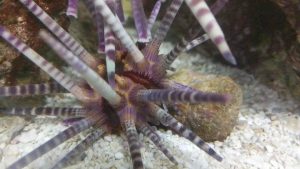New Creatures Arrive at Central Campus
A new shipment of creatures has arrived at the Central Campus Aquarium, home of one of the top high school marine biology and aquarium science programs in the nation.
The aquarium’s inhabitants now represent most of the species in the world’s oceans, according to Marine Biology instructor Greg Barord. He said students will benefit from having a wide range of lifeforms to study.
“Invertebrates (starfish, crabs, urchins, squid, nautiluses, etc.) make up most of the animals in the oceans,” Barord said. “It’s through their diversity that the ocean ecosystems are able to function as well as they do.”
The animal featured in the photograph is a Red Imperial Sea Urchin (Phyllacanthus imperialis), a native of the Indo-Pacific Region. The photo was taken shortly after the urchin’s arrival at Central Campus. Barord said this urchin and others like it have the potential to provide his students the opportunity to study reproduction close up.
“We hope the urchins will spawn in captivity (release gametes into the water) so we can learn about embryology, the study of embryos and embryonic development that apply to all animals, including humans. Unlike humans, who undergo internal fertilization, sea urchins undergo external fertilization so we will be able to observe the first stages of new life developing. For these reasons, sea urchins have been used for years to better understand the developmental processes of many other animals.”
To see more photos and follow along with students as they learn about these new additions, visit the Central Campus Marine Science Facebook page or follow the students on Twitter @CCMarineScience.





